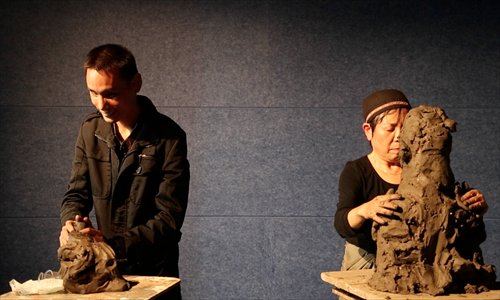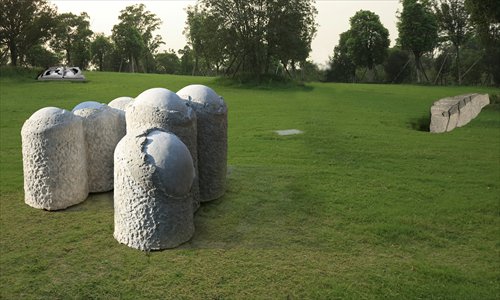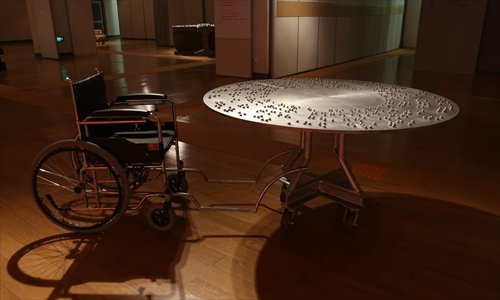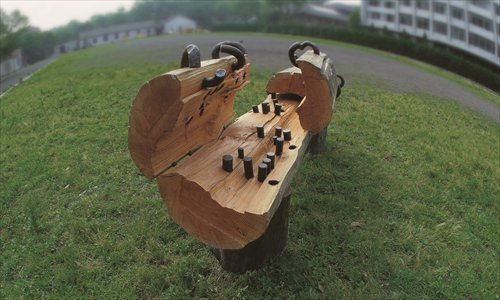Connecting the dots

Artist Li Xiuqin (right) and the blind Xu Mazheng sculpt each other's faces with clay.
With eyes closed, artist Li Xiuqin and the blind Xu Mazheng explore each other's faces with their hands. Next they sculpt what they felt with clay.
This was a performance given at Li's ongoing solo exhibition at Shanghai Baoshan International Folk Arts Exposition. Titled Connecting Art and Society in Braille: 20 Years of Sculpture Works by Li Xiuqin, the exhibition showcases a series of sculptures featuring Braille-like patterns and calls attention to the challenges faced by the visually impaired.

A series of sculptures featuring Braille-like patterns are on display at artist Li Xiuqin's exhibition Photos: Courtesy of the gallery
Sixty-year-old Li is an energetic and optimistic lady who speaks in a firm voice and a lilting Shandong accent. More than 30 years ago, she was given a temporary window into an another world.
In 1982, Li graduated as a sculpture major from the Zhejiang Academy of Fine Arts (now known as China Academy of Art) in Hangzhou and secured a teaching job on campus. However, a sudden attack of rheumatic fever struck her during a summer visit to Heilongjiang Province and severely affected her eyesight for about a month.
"I felt so depressed during that time, because I was just about to start working at my college," sighed Li, who still teaches at the same art academy. "But it never occurred to me to use the experience for art."
It took Li 10 years to think of incorporating the painful experience into her sculpture work, after she was introduced to the compelling possibility of contemporary art through her postgraduate study at Manchester Metropolitan University.
In 1993, Li's first exhibition Touching the Concave-convex, was held in the library at the Zhejiang Academy of Fine Arts, featuring 15 sculptures under the theme of Braille. The works magnified the small characters of Braille, the tactile writing system that conveys meaning through raised dots, and were completed with the help of teachers and students from the Zhejiang School for the Blind. At the opening ceremony, a group of blind students were invited to experience the works through touch.
"They liked the sculptures very much," recalled Li. "The texture of the sculptures might have been strange to them, but the arrangement of the concave and convex bumps conformed to real Braille words that they were familiar with."
Since then, the concave and convex series has become a stable and enduring project for Li, who has expanded the series with varied materials to explore different themes over the past 20 years.

A series of sculptures featuring Braille-like patterns are on display at artist Li Xiuqin's exhibition Photos: Courtesy of the gallery
Works on view at the Baoshan International Folk Arts Exposition include the original Concave and convex series from 1993; The Opened Memory, featuring a cleaved wood trunk dotted with a number of metal columns ; Self-ferrying, which consists of a wheelchair and a rotating table carved with Braille; and Life, which features a number of aluminum columns forming the Braille word for "life" (top left).
Most of the concave and convex dots are arranged according to the Braille system, Li told the Global Times. But what really matters to her works, said the artist, was not the meaning of the specific Braille words, but the effect the dots have on people who are not blind.
"It opens a door to a different world for non-blind people and also invites them to reflect on their own life," said Li. To reinforce the experience of visitors, the two entrances to the major exhibition hall have been transformed into two dark passages which aim to resemble the viewless world of the blind.
Li's interaction with the blind is also revealed at the exhibition. Xu Mazheng was one of the student visitors to Li's exhibition in 1993. Last year, Li revisited the students and invited them to once again collaborate with her. Now Li's and Xu's improvised creation are on display together with a series of portrait sculptures completed by Li and other students, as well as a documentary recording Li's second visit to meet the students.
The exhibition's curator, Shanghai-based art critic Wang Nanming, said that Li's works, featuring a minimalist style influenced by pop art, do not merely represent personal expression, but also engage with a social issue.

A series of sculptures featuring Braille-like patterns are on display at artist Li Xiuqin's exhibition Photos: Courtesy of the gallery
Wang believes that though art may not provide concrete solutions to social problems, it can be an effective way to raise awareness of issues, which may help to change public perceptions. In Li's case, she used her own experience to create art that calls for justice and care for a larger group of people.
Li's Braille series won't stop in the future. Li recalled an experience at the exhibition which moved everyone present to tears. A blind man told Li that if he was able to make a sculpture, he would make a bad back. When Li asked why, the man explained that since he's a masseur, that's what his hands are most familiar with.
Date: Until April 15, 9 am to 4 pm (closed on Mondays)
Venue: Shanghai Baoshan International Folk Arts Exposition
上海宝山国际民间艺术博览馆
Address: 4788 Hutai Road
沪太路4788号
Admission: Free
Call 5604-2007 for details